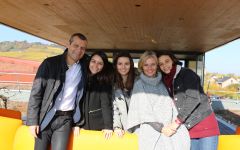Gustave Lorentz Riesling Reserve 2015
-
Wine
Enthusiast



Product Details
Your Rating
Somm Note
Winemaker Notes
This is an excellent wine for grilled, lightly cooked and raw seafood and fish, as well as chicken, pork, veal and goat cheese.
Professional Ratings
-
Wine Enthusiast
Hints of savory earth mingle with fresh apple notes. The palate has the bright mellow freshness of ripe oranges and the juiciness of ripe pear. A core of bright lemon acidity makes for a clean, bright and refreshing finish.
Other Vintages
2021-
Wine
Enthusiast
-
Wine
Enthusiast





The Lorentz family has been making wine since 1836 in the heart of the Alsace, which lies in the northeast corner of France, along the Rhine River. Charles Lorentz Sr., grandfather of the current president of Gustave Lorentz, developed his vineyards on the hills of Altenberg de Bergheim, in the foothills of the Vosges Mountains, which has grown to 85 acres in this extraordinary terroir, with four acres planted on the hills of the Grand Cru Kanzlerberg and 30 acres in the Grand Cru Altenberg de Bergheim.
The current management, led by Georges Lorentz, is the sixth generation of the family firm, headquartered in the medieval village of Bergheim, in the Haut-Rhin. As far back as anyone can recall, the grapes harvested from this extraordinary terroir have been vinified separately. Thus, Riesling, Pinot-Gris, Gewurztraminer and other Muscat varieties from the Altenberg de Bergheim vineyards unerringly express their unique qualities in these wines year-to-year. The family is very proud that the wines are “gastronomic,” meaning fresh, clean, well-balanced and mostly dry – great matches for many of the cuisines from the more than 55 countries where the wines are sold. As they have down through the generations, the Lorentz family hues to tradition while also employing state-of-the-art vinification techniques and equipment. Gustave Lorentz was among the first producers in the Alsace to use stelvin (screw-cap) closures. In 2012 the Gustave Lorentz vineyards became certified organic by Ecocert.

Riesling possesses a remarkable ability to reflect the character of wherever it is grown while still maintaining its identity. A regal variety of incredible purity and precision, this versatile grape can be just as enjoyable dry or sweet, young or old, still or sparkling and can age longer than nearly any other white variety. Somm Secret—Given how difficult it is to discern the level of sweetness in a Riesling from the label, here are some clues to find the dry ones. First, look for the world “trocken.” (“Halbtrocken” or “feinherb” mean off-dry.) Also a higher abv usually indicates a drier Riesling.

With its fairytale aesthetic, Germanic influence and strong emphasis on white wines, Alsace is one of France’s most unique viticultural regions. This hotly contested stretch of land running north to south on France’s northeastern border has spent much of its existence as German territory. Nestled in the rain shadow of the Vosges mountains, it is one of the driest regions of France but enjoys a long and cool growing season. Autumn humidity facilitates the development of “noble rot” for the production of late-picked sweet wines, Vendange Tardive and Sélection de Grains Nobles.
The best wines of Alsace can be described as aromatic and honeyed, even when completely dry. The region’s “noble” varieties, the only ones permitted within Alsace’s 51 Grands Crus vineyards, are Riesling, Gewurztraminer, Muscat, and Pinot Gris.
Riesling is Alsace’s main specialty. In its youth, Alsace Riesling is dry, fresh and floral, but develops complex mineral and flint character with age. Gewurztraminer is known for its signature spice and lychee aromatics, and is often utilized for late harvest wines. Pinot Gris is prized for its combination of crisp acidity and savory spice as well as ripe stone fruit flavors. Muscat, vinified dry, tastes of ripe green grapes and fresh rose petal.
Other varieties grown here include Pinot Blanc, Auxerrois, Chasselas, Sylvaner and Pinot Noir—the only red grape permitted in Alsace and mainly used for sparkling rosé known as Crémant d’Alsace. Most Alsace wines are single-varietal bottlings and unlike other French regions, are also labeled with the variety name.
